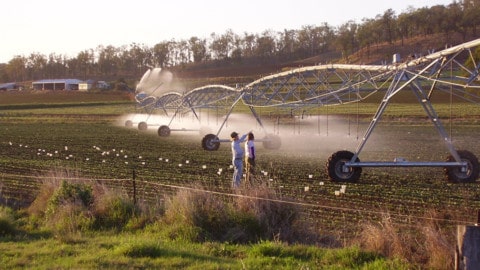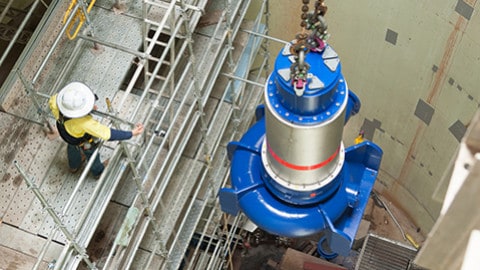Rising groundwater levels in Bendigo’s historic mines has been causing odour problems and impacting on water quality. To combat the problem, the Department of Environment, Land, Water and Planning (DELWP) in partnership with Coliban Water, implemented a transitional solution to pump the groundwater from the mine voids to a treatment plant.
With construction of the transnational solution now complete, DELWP is searching for a permanent solution for managing the groundwater. Naturally occurring groundwater in the historical mines beneath Bendigo, north west of Melbourne, was originally suppressed through pumping during mine activities, however it has been recovering to natural levels since mining activity ceased in 2011. It started to become a problem in early 2015 when it began causing odours, impacting local water quality and resulting in small surface discharges. It also had the potential to impact local infrastructure.
The groundwater contains elevated levels of hydrogen sulphide gas (rotten egg gas)—which was causing the odour—as well as salinity, arsenic and other heavy metals.
A transitional solution
Late last year, construction of a $27.4 million state-of-the-art groundwater management system was completed, providing a transitional solution to the problem and will operate for four years until a permanent solution can be implemented.
The project was funded by the Victorian Government and included refurbishment of a treatment plant at New Moon, north of Eaglehawk, building two pipelines from New Moon to Coliban Water’s Bendigo Water Reclamation Plant in Epsom, and creating a new brine storage lagoon at the plant.
Pumps transfer groundwater from the mines to the New Moon Groundwater Treatment Plant, where it is treated to remove arsenic, salt, heavy metals and hydrogen sulphide. The treated water is then sent to the Bendigo Water Reclamation Plant in Epsom via a pipeline where, if possible, it is reused or returned to the environment. The salty water from the treatment process is piped via a second pipeline to the Bendigo Water Reclamation Plant to a brine storage and evaporation lagoon.
The submersible pumps being used to move groundwater from the Central Deborah Mine—consisting of a 95kw pump motor and 20 pump stages in the wet end—were chosen as they met the requirements of pumping groundwater, which was a head pressure in excess of 260m and maximum volume of two ML per day, per pump.
Other considerations were lead time, as well as the ease of acquiring spare pumps and parts, the cost, and the reliability of the pump units. Having two provided redundancy and allowed pumping at higher than normal rates when required.
Since being installed, the pumps have pumped 1.5 to two ML per day from minus 40mAHD to surface 220mAHD. Water extraction from the Central Deborah Gold Mine is owned and managed by Bendigo Heritage Trust which also manages groundwater pumping at the Londonderry Shaft on the Garden Gulley Reef.
Groundwater extraction also occurs at the New Moon Mine Shaft on the Garden Gully Reef at an average rate of two ML per day or 730 ML per year. This pump is owned by GBM Global.
Construction was completed in September 2017 and the system will operate until June 2021.
Lendlease designed and constructed the groundwater treatment plant, Veolia Water Network constructed the pipelines, and Ward Bros from Rochester constructed the brine storage lagoon.
Member for Bendigo West, Maree Edwards, said, “This community-led solution not only gives assurances for the future but importantly safeguards our ever-popular Central Deborah Gold Mine, as well as our local waterways from rising groundwater.”
Looking for a permanent solution
With the transitional solution now complete, DELWP—on behalf of the Bendigo community—is now working on a long-term solution to the town’s rising groundwater that will last 25-30 years.
The permanent solution needs to identify ongoing funding and governance options, as well as incorporating the management of groundwater from historic mines other than Central Deborah. Through the Innovation for a Permanent Solution process, the Bendigo Groundwater Project aims to gather concepts about how Bendigo might best manage groundwater in the mine voids, consistent with community and stakeholder expectations. It is expected that the investment to date in research, design, planning and the infrastructure used in the interim solution will be used to inform the long-term solution.
Consultation on a permanent solution began in late 2017, with industry, academia, community organisations and the public invited to submit their ideas for sustainable, long-term treatment and funding options. Submissions closed in late February 2018.
Turning groundwater into energy
One idea put forward is turning the gold mine into a pumped hydro site. Such a solution would not only help manage groundwater levels in the mine voids, but would also deliver peak energy generation capacity to put downward pressure on power bills.
Mines cover a number of requirements needed for pumped hydro storage, including a large area with elevation differences, low environmental impact, grid connection proximity and a water source. For this reason, a number of mine sites around Australia are being considered for pumped hydro facilities, including Kidston Gold Mine in QLD, Iron Duchess Mine in SA, and Muswellbrook Coal Mine in NSW, among others.
Rock stability at mine sites is one of the main concerns around developing them into pumped hydro facilities, however preliminary work at Bendigo suggests that the hard nature of the rock and the construction techniques used when mining will make it suitable.
The concept for the Bendigo site includes a generation capacity of 30MW and a storage capacity of six hours of energy (180MWh) with a round trip efficiency of around 70 per cent. The Garden Gully reef mine voids would be used as an upper storage volume, while the Swan Decline would be used as a lower storage volume. These two voids would be linked by a 1.5m diameter shaft, allowing water to follow between them, and valving to isolate flow.
At the bottom of the shaft, a new structure would be excavated off the decline where the turbines would be kept, with another structure 150m below this to house the pumps. The lower structure would be linked to the top structure by a wide shaft for personnel and crane access.
The system would be connected to the 66kV sub transmission network in Bendigo and would link into a new substation on the site of the Eve Street vent shaft where the power cable would be installed.
This submission as well as others are currently being reviewed and evaluated by reference groups, who will make recommendations as to which options should be investigated further.
















